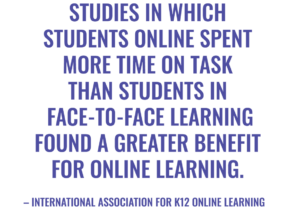 Mental health is a critical aspect of overall well-being, especially during times of stress and uncertainty. Virtual education can support positive mental health outcomes in a variety of ways. Below is a list of seven ways virtual education can support the mental health of students. From providing more flexibility and control over schedules to reducing social pressure and anxiety, virtual education has many benefits that can positively impact mental health.
Mental health is a critical aspect of overall well-being, especially during times of stress and uncertainty. Virtual education can support positive mental health outcomes in a variety of ways. Below is a list of seven ways virtual education can support the mental health of students. From providing more flexibility and control over schedules to reducing social pressure and anxiety, virtual education has many benefits that can positively impact mental health.
1. Flexibility and Control Over Your Schedule
Control over your schedule is one of the most appreciated benefits of virtual education, which can positively impact the mental health of students and parents. Both students and parents can customize their schedules to work best for their lifestyles. This could mean starting the day earlier or later or even doing schoolwork on the weekends. Frequent breaks are also a significant benefit of virtual learning.
This amount of control can help reduce anxiety and stress since a fixed schedule is not necessary. In addition, students can better manage their virtual curriculum workload, which allows for more self-care activities like spending time with family and friends, exercise, meditation, or hobbies. Finally, students who control their schedules feel empowered in their education, which helps with motivation and well-being.
2. Reduced Stress from Transportation
The daily commute for in-person instruction often includes riding a bus or dealing with traffic. When we eliminate the need to commute because of virtual learning, it can reduce stress levels, anxiety, and frustration, thus improving students’ mental health. Also, students can use the time saved for activities like starting class early, focusing on hobbies, or exercising.
3. Fewer Distractions and Interruptions
In a virtual learning environment, students are free from the social distractions and interruptions they may experience in a traditional classroom. With more control of their learning environment, students can create a learning space free from interruptions and distractions, allowing for greater focus and productivity.
4. Personalized Learning Experience
Another significant advantage of virtual learning is the personalization of the experience. Students can learn at their own pace according to their individual needs, which can lessen anxiety and stress substantially.
Students who fall behind or feel challenged by a subject often experience frustration. A personalized virtual learning experience can address this frustration with tailored support and resources, which may boost confidence and motivation and provide a greater sense of fulfillment academically.
5. Opportunities for Communication and Collaboration
With virtual learning, students can connect and collaborate in various ways, like through video conferencing and virtual discussion boards. These tools make connecting with peers and teachers easy and convenient.
6. Trust Between Students and Teachers
Excellent communication is necessary between students and teachers in virtual education. Teachers check in frequently with students to ensure they understand the curriculum and are hitting their assignment deadlines, which builds a sense of connection and trust. Students who feel a teachers’ investment in their learning no doubt will benefit from the positive connection with a caring adult.
7. Reduced Social Pressure and Anxiety
Some students struggle with social anxiety in a traditional classroom. In a virtual setting, these students tend to feel less pressure to interact with peers or fit into the social norms of a brick-and-mortar classroom. Having a more comfortable learning environment online can help shed social anxieties and lead to positive mental wellness outcomes.
Virtual education has many advantages that can contribute to positive mental health for students. The flexibility and control over schedules, reduced stress from transportation, fewer distractions and interruptions, personalized learning experiences, opportunities for communication and collaboration, trust between students and teachers, and reduced social pressure are just a few of the reasons students are choosing virtual education.


